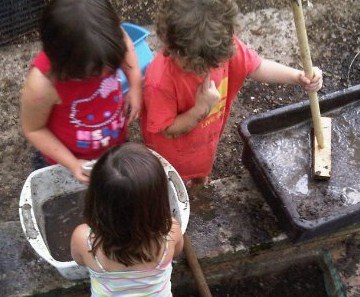The playground as classroom
/Michelle Mattalino, who contributed this guest post, is the owner and executive director of The Olive Tree Learning Center, an innovative Austin preschool that emphasizes outdoor learning and follows the Reggio Emilia approach to early childhood education.

On our playground, under the skyward reaching branches of the oak trees that span hundreds of years, I can hear the lilting laughter of children approaching. As the chatter and energy begin to increase, I know the students are about to flood out onto the playground in a wave of pure motion and purpose. Every student has a mission, it seems. Some flock to the trucks, some to the shovels, others to the playscape and swings, and often a small group will huddle in the playhouse. Each student chooses a mode of play, and then, as in a dance, switches partners, materials, and activity levels. It is perhaps the most fascinating part of my day and the main reason I have based my teachings on the child development work ongoing in Reggio Emilia, Italy.
One of the questions I receive most frequently is “What is Reggio?” The succinct answer is that Reggio is your child. Each child is different, reacting and responding uniquely to the environment and community. The Reggio Emilia model provides children with individualized platforms on which to explore and collaborate, along with guides who can hear and receive their experiences and provide reflection and more research to add to their learning; an environment that is carefully crafted with materials, sensory items, and tools to further their discovery; and a community that lifts them up with respect, understanding, and freedom.
Here at The Olive Tree, I have a deep love and admiration for the team of educators (we call guides) whom I am blessed to work with in applying the Reggio philosophy. The guides and I meet extensively to reflect and research on the words and actions of our students. We present and re-present materials, subjects, and topics that the students have found fascinating, either individually or as a group, and provide the children with the tools and structure necessary to further develop these burgeoning interests.
The guides document learning and exploration for the students and parents to see in pictures and written dialogue. This documentation becomes our pathway for further investigation into a topic, choice, or experience. We walk with them along this discovery path, hand in hand, asking questions and documenting the answers for further thought and focus.
At the end of the day, our children always say that their favorite part was playing. Yes, learning is playing, and the playground is where children assimilate all the information of the day through application and practice, whether they choose the trucks or the playhouse or something else.  With graduation around the corner, I reflect on what I would like my students to take with them from their time on our playground. My wish is for all my students to be able to hear their own voices, through a crowd or while alone; to remember that learning is about how you approach and think about a situation or problem, not necessarily how well you perform, and that mistakes are essential to the growth process and should be viewed as opportunities; to understand how to be safe and healthy; and most importantly, to know that they are capable, competent, and powerful in their own right.
With graduation around the corner, I reflect on what I would like my students to take with them from their time on our playground. My wish is for all my students to be able to hear their own voices, through a crowd or while alone; to remember that learning is about how you approach and think about a situation or problem, not necessarily how well you perform, and that mistakes are essential to the growth process and should be viewed as opportunities; to understand how to be safe and healthy; and most importantly, to know that they are capable, competent, and powerful in their own right.
Michelle Mattalino









